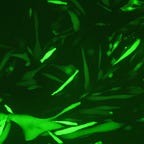Using Limma to find differentially expressed genes
Ritchie, ME, Phipson, B, Wu, D, Hu, Y, Law, CW, Shi, W, and Smyth, GK (2015). limma powers differential expression analyses for RNA-sequencing and microarray studies.Nucleic Acids Research 43(7), e47.
limma is an R package hosted on Bioconductor which finds differentially expressed genes for RNA-seq or microarray. Recently I’ve been working on a PCR-based low-density array and noticed that I forgot how to use limma for the one hundredth time, so I decided to make a note.
Material
- Log-transformed expression data in a matrix:
Each column represents an experiement, and each row represents a detected gene/probe. - Design matrix:
Each column represents a status of your data (e.g., wild-type, mutant, rescued…), and each row corresponds to an experiment in the expression matrix. This could be generated from anexpressionDatasetobject, or we could create this manually if you only have a raw expression dataset like me.
# Create a design matrix
design <- model.matrix(~ 0+factor(c(1,1,2,2,3,3)))# assign the column names
colnames(design) <- c("Wild_type", "Mutant", "Rescue")
The code above should generate something like this:
- Contrast matrix: Then, we must tell limma whom we are going to compare with whom.
cont_matrix <- makeContrasts(MutvsWT = Mutant-Wild_type, MutvsRes = Mutant-Rescue, levels=design)The code above would give:
Analysis
Now, I am pretty much ready (except for the need to understand the math).
# Fit the expression matrix to a linear model
fit <- lmFit(exp_matrix, design)# Compute contrast
fit_contrast <- contrasts.fit(fit, cont_matrix)# Bayes statistics of differential expression
# *There are several options to tweak!*
fit_contrast <- eBayes(fit_contrast)# Generate a vocalno plot to visualize differential expression
volcanoplot(fit_contrast)# Generate a list of top 100 differentially expressed genes
top_genes <- topTable(fit_contrast, number = 100, adjust = "BH")# Summary of results (number of differentially expressed genes)
result <- decideTests(fit_contrast)
summary(result)
Have fun with the result, and enjoy some experiment time.
